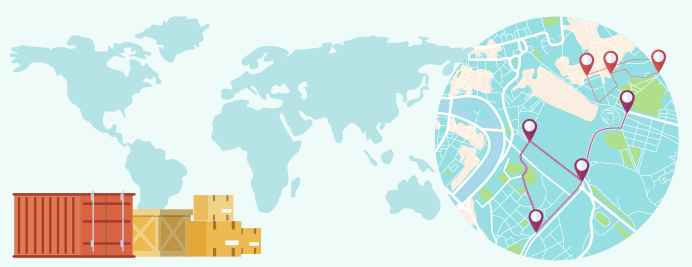Blog Summary: A robust communication and information processing system always optimizes operational efficiency in logistics throughout the movement of items from manufacturing units to the end-users. This article unfolds how a unified platform can help improve service quality at every stage of the supply chain and increase the support team's productivity to address the growing customer demand for faster delivery.
“We’re experiencing increased demand. Pressure is being put on the supply chain. The want is to ship the goods to the consumer as fast as possible,” — says the director of operations with a logistics company.
Perhaps your views will echo if you’re in charge of similar responsibilities. As you know, a lot happens in the logistics ecosystem. For instance, there is a plenty of moving items. Trucks are on their way. Loading and unloading take place. Inventory is stacked inside the warehouse. The orders are shipped, ensuring everything remains perfect during transit. And then the final delivery of the items to the consumers. It’s quite a task!
According to a report from Harvard Business Review, the supply chain mechanism of yesteryears will perish in the next five years. The old systems will be replaced by contemporary, feature-rich, automated solutions for seamless operations.
Necessity of a multichannel communication tool in logistics
A multichannel communication system is a one-stop solution that integrates all methods of communication technologies and collaboration capabilities. In practice, this means, if you implement a similar solution, you can expect an inflow of multichannel messages, mobility features, file management, data sharing, and case management – everything you need to deliver excellent customer service, and that too on a single platform. Such tools are highly effective for the supply chain.
Let’s discuss the importance of a multichannel communication tool that is embedded in an AI Helpdesk.
1. Team collaboration and productivity
With seamless communication comes effective collaboration. When team members share information more quickly across departments, operational efficiency automatically gets enhanced.
From accessing all types of electronic messages in the same mailbox to spontaneously triggering required actions, unified helpdesk tools simplify communication for service representatives, production, supply chain, and management.
Here, case management is also pivotal in facilitating transparency in actions across departments. Essentially, the case management tool, again a vital feature of an AI Helpdesk, aims to automate the process of tracking and controlling support issues.
With this tool, users can log into the software and generate a ticket when an issue is found at any stage of the supply chain. The ticket will have a unique number and will be routed to the concerned department for resolution. Some of the key benefits of this feature are:
- Workers can share information quickly
- Find answers to customer inquiries fast
- Collaborate with other departments in real-time

2. Automate processes for efficient management of the supply chain
In a fast-paced world, your customer expects deliveries on time. Their expectations continue to rise where two days or even same-day shipping becomes the norm. Additionally, demand can also surpass supply if all departments of the supply chain are not in proper sync. It usually happens due to a lack of a standardized approach. And this results in unfulfilled orders.
Meeting these demands require reliable collaboration – from the manufacturing units to the warehouse to the point of delivery – to help streamline operations by minimizing cost. Helpdesk communication tools give you the power to unify departmental collaboration where all workers can instantly communicate.
Bonus feature: A trending technology in logistics that is in high demand is Route Optimization, backed by artificial intelligence. Route optimization is the process of finding the best route to ship and deliver a package from the manufacturing unit to the end recipient as quickly and cost-effectively as possible. This process is focused on minimizing the total shipping time.

3. Meaningful interaction and transparency
Service representatives generally have vital information about customers' preferences, buyer persona, and purchasing history. They can play an active role in facilitating transparent communication among the stakeholders. From placing an order until its delivery, everything in between (which includes customer inquiry, complaints, and getting support) are supported by a communication system backed by helpdesk technologies.
With the right solution, interactions remain jitter-free. Customers have more options for reaching representatives via multi-channel interfaces—social media, email, chat, calls, web portals, etc. It also enables logistics companies to seamlessly operate with agents in different locations while still maintaining a standardized approach to serving customers.
A Bonus Feature: Helpdesk systems often come with Calendar Integrations. It helps maintain the flow of client communication by ensuring that no one has to switch platforms to schedule a follow-up or send a reminder.

Introducing AI and ML to automate workflows
As we are venturing into an ultra-digital world, it’s tough to ignore the power of AI. The logistics industry can benefit a lot from this technology.
Logistics is an industry that relies on physical and digital networks. The amount of data generated from the producer, the shippers, the warehouse, and the physical assets in the transport to the end customer is certainly a goldmine for applications where AI is the dominant force. Thus, it would be best if enterprise brands could leverage these modern-day applications to optimize business processes.
AI-driven technologies bridge the gap between supply and demand by automating manual processes and enabling data-driven decisions. Watch this video:
Logistics is becoming increasingly digitized in the modern business world, and robots do much of the work. However, connecting people with the manufacturing and supply chain cycle is more important than ever. Thus, a unified multichannel communication software suite like ThinkOwl is the key to strengthening these connections. Logistics companies must look forward to implementing unified technology to build a high-performing supply chain ecosystem and delight their customers at every touchpoint.
So, what’re you waiting for? Feel free to contact the ThinkOwl team. We’d love to assist you with all the information you need. Sign up for a 30-day free trial now.












